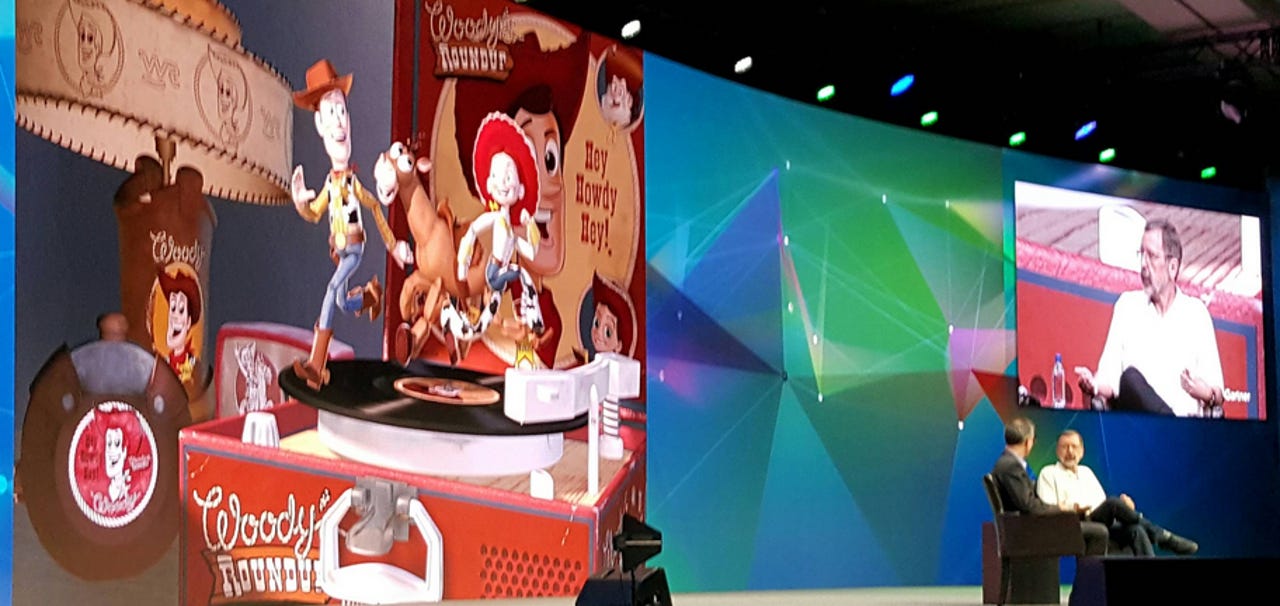Creativity 101 with Dr. Ed Catmull, president of Pixar, Disney Animation


ORLANDO--Dr. Ed Catmull, president of Pixar and Walt Disney Animation Studios and Disneytoon Studios, has threaded the needle between creativity, arts and technology largely through trial and error.
Catmull, author of Creativity Inc., walked through a few creativity takeaways at the Gartner Symposium ITxpo. Here's a look at some key lessons for the corporate creativity front.
Gartner Symposium
Don't define creativity narrowly. Catmull said that most people think of the arts or engineering with creativity. "I think that's too narrow. Creativity is problem solving and how do we think about them," explained Catmull. "The act of working on those problems is a creative act. For me it's a freeing concept. I think people are naturally creative. What are the management and cultural barriers to being creative?"
Management's job is to allow people to be creative, he added.
Teams matter. When making Toy Story 2, Catmull recalled how Pixar figured it could take a new team and create a movie. It was a disaster that needed a bailout from the first Toy Story movie team, which was working on Bug's Life at the time. Pixar had a development team that scouted for ideas, but the team building was overlooked. "If you give a good idea to a poor team they will screw it up," said Catmull. "If you give a mediocre idea to a good team they will make it better or come up with a better idea. Our only job is to put together a team that can solve the problem."
Catmull said you have to protect the team that is working on an idea which doesn't work. Don't judge a team in the process of trying to work things out, he said.
Create a brain trust. Create a brain trust and it has to be peer-to-peer, not a boss. "People that have been through it," he said. "The group isn't permanent." Also remove the power structure from the room. "The director can't tell them what to do," said Catmull. "The reason you do that is because the leader will already be in defensive posture."
Another core part of the brain trust is that there's shared ownership in joint success. In addition, you have to listen. This brain trust approach works, but can often be a complete disaster, he said. "There are a lot of things, as humans, that can get in the way of being honest," said Catmull.
Rid ego from the room. Catmull said the brain trust size will depend on the problem. Large groups have showboating. Small groups are normally better. But the key is to check egos at the door. "When we're in a group solving a problem and everyone is thinking about it as their problem, there's no better feeling," said Catmull.
Two meanings of failure. When you fail in the past, you learn and it is what made us who we are, said Catmull. That's the academic view. The second meaning of failure is the one we learned in school. That means you didn't work hard or screwed up. In work world, projects fail, governments fail, relationships fail and companies fail. "There is a real palpable aura of danger around failure," said Catmull. Both forms of failure exist at the same time. Failure is a necessary consequence of doing something new. Managers need to know both meanings of failure exist for employees and do what they can to turn it into a learning experience.
New culture. Catmull recalled the relationship changes when Pixar was acquired by Disney. Disney was struggling with animation and open to change. However, there was a feed-the-beast mentality. "Creative was run by production so the balance was out," he said. "Let's get the balance right. Don't confuse the creative front end with the process."
Bolt wound up being the first movie with the new approach. The company had issues with rendering the hamster in the movie named Rhino, technology and what needed to be done creatively. In a nutshell, Rhino had to be re-rendered. Deadlines were about to be missed because the process to prevent errors would take six months, according to the animation developers. A small team re-rendered a character in four days. Why the gap? Processes were in place to have no errors in the rendering. The lesson: "It's better to fix problems than trying to prevent them all," said Catmull.
Another key point on culture is that Disney agreed with Pixar's principles right away. It took four years to implement and integrate them. "You have to look at why you can't adhere to your own principles," he said.
Steve Jobs. Catmull worked with Jobs throughout his career and went through the hero's journey of change. Catmull said Jobs was smart enough to learn that his early approach to people didn't work. He became empathetic and a good partner. "People don't know about what that Steve was like," said Catmull. "It was a series of failures that led to new Steve, the one that created Apple's success." Was Jobs in the brain trust? No. Catmull said Jobs personality meant that you couldn't have a meeting without a power structure so he avoided them.